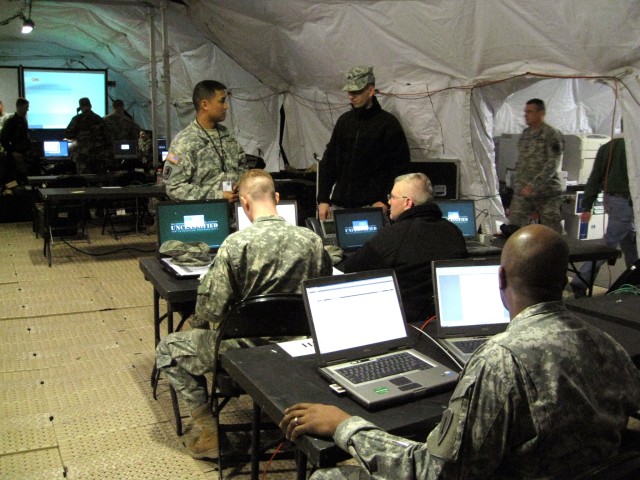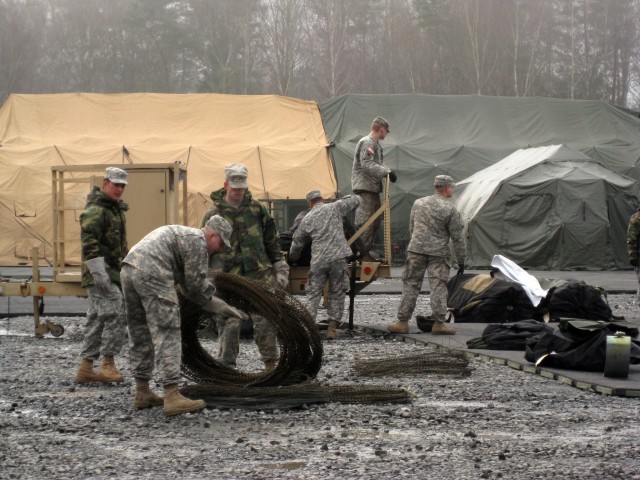HEIDELBERG, Germany - (Army News Service, April 14, 2008) - The establishment of early-entry and operational command posts in late March during the deployment phase of Austere Challenge 2008 marked a significant milestone in the merger of U.S. Army Europe and V Corps into a single organization known as 7th Army.
Equipment, vehicles, and high-tech electronics flooded into Grafenwoehr Training Area. Soldiers from staff sections of V Corps and USAREUR headquarters elements then established a deployed command post ready to provide command and control for a joint task force engaged in combat.
"It's part of the 7th Army transformation. We're bringing together the USAREUR staff and the V Corps staff into a single functional staff," said Lt. Col. Ransford A. Reinhard, V Corps deputy chief of operations. "It's a different paradigm than what we're used to."
Lt. Gen. Kenneth W. Hunzeker, V Corps commanding general, said AC08 is the first test of the 7th Army operational headquarters concept.
"This is more than an exercise; it's a means to demonstrate how a deployable, functionally aligned Army headquarters will operate in the 21st century," he said.
The theory, developed through several months of intense staff planning, will culminate in the final phase of AC08, scheduled to begin in late April.
The first phase, "DIGEX," conducted in mid-February, focused on technology. During the exercise, participants set up and tested phones, computers and networks to ensure reliable communications. In the second phase a staff exercise allowed sections to rehearse their roles in the command post function. The third phase, the deployment exercise in late March, verified the ability to set up a functional command post beyond the USAREUR and corps home bases in Heidelberg.
The final phase will combine lessons learned during earlier phases in an exercise simulating a full-fledged combined joint command post operating in a combat zone.
"(The Army has) always been challenged to do more with less," said Maj. Michael Petrunyak, V Corps chief of Chemical, Biological, Radiological and Nuclear Operations. "This is actually an extension of that challenge, and how we do that will be the point of this exercise. The challenge is transforming our mind-set."
With the final phase of this year's Austere Challenge exercise scheduled to begin at the end of this month, the deployment phase was designed to detect any difficulties in mobilizing and deploying the combined staffs, as well as to give each staff section a chance to appraise its ability to integrate into the command post, said Reinhard.
During the deployment exercise, Master Sgt. Terry L. Daniel from the V Corps operations division said the concept AC08 is testing appears to be coming together.
"I think it's working," Daniel said. "It's something new for all of us. We're merging (into) an even bigger, more efficient unit."
Austere Challenge was intended to iron out specific challenges. Reinhard said the implementation of a new prototype has realigned the combined staffs' command structure, obliging staff sections to work more closely as a team.
Under the new blueprint, the command post brings together different functional groupings under a common banner to better manage joint combat operations in a hostile environment. Those operations involve everything from managing transportation and logistics to sifting through combat intelligence and continually ensuring clear avenues of communication vital to the command and control of a task force in combat.
"People are used to working in an area they know," Reinhard said. "By having (staff elements working) so close together as you plan and as you execute, you've got those guys there and you can count on them to help you."
For some, that team-building synergy is best developed through the hands-on experience an exercise like Austere Challenge provides.
"The trick is training ourselves to transform, rather than just briefing it," Petrunyak said.
"Everyone knows the plan," he added. "Everyone knows what has to be done. It's just bringing it all together that serves as one of the major challenges of what we have here."
Hunzeker assessed the exercise to date as a success.
"Our team, which is a combination of USAREUR, V Corps, 21st TSC and 5th Signal Command, has really taken the new headquarters concept and run with it," he said. "Their efforts have been, and will remain, critical as we move further down the road to the future 7th Army."
Although Austere Challenge 2008 has been a mammoth undertaking, many agreed that it has been a success thus far. Petrunyak said that initially communication systems presented a hurdle, but those problems were fixed quickly.
Reinhard attributed much of the successful deployment exercise to the many Soldiers who put up tents, assembled modular flooring and completed all the other work needed to put the intricate command post together and keep it running.
"All of this happens because of a lot of Soldiers put a lot of hard work into it," Reinhard said during the deployment exercise. "It's going good."
"We've been successful to this point," Daniel said. "We got on the ground, we got the equipment up, and we got everything set up. We've been a successful operation."
"We're not done yet, but right now I'd say we're riding high," Petrunyak agreed.
(Spc. Joseph McAtee serves with the U.S. Army Europe Public Affairs Office.)




Social Sharing